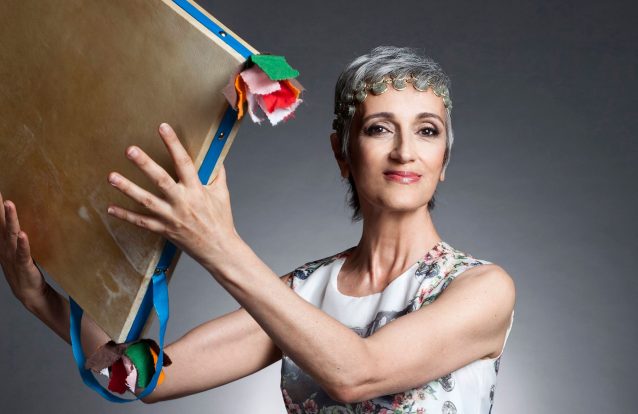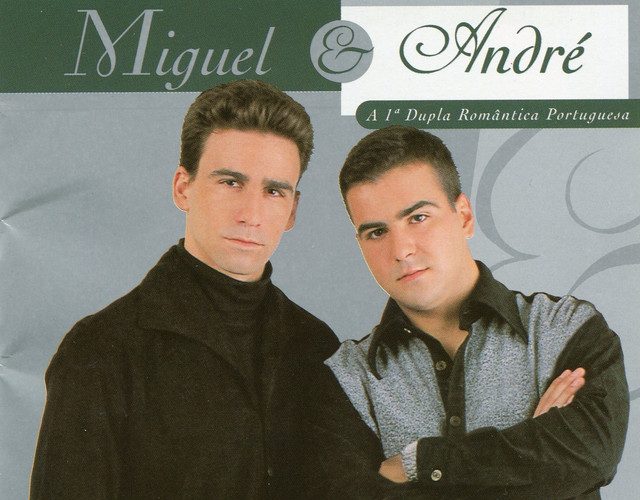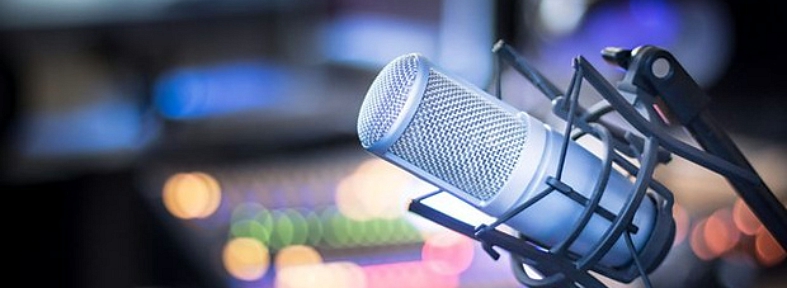Born in Porto on August 10, 1959, Né Ladeiras is the artistic name of the Portuguese singer Maria de Nazaré de Azevedo Sobral Ladeiras.
She was born into a family with great affinities with music. Her mother sang on radio programs, her father played the guitar and her maternal grandfather played Portuguese guitar, braguesa, cavaquinho and percussion instruments. At the age of 6, she participates in the Festival dos Pequenos Cantores in Figueira da Foz. During her adolescence she was part of several musical projects, including an acoustic duo formed with a friend from school.
His musical career really began with the founding, in 1974, with several friends, of the Brigada Victor Jara, a project in which they mainly played Latin American music, having participated in various cultural animation campaigns of the MFA (Movimento de Forças Armadas) and work voluntary. The group’s interest in traditional Portuguese music only manifested itself in the last months of 1976, after performing several shows across the country and there “discovering” the potential and quality of our musical tradition.
In 1977, following a performance at FIL (Feira Internacional de Lisboa), they maintained contacts with the Mundo Novo publishing house (associated with the publishing company Caminho), for which they recorded, over two days, the album Eito Fora, which was published in the same year. year. Né Ladeiras interprets, on this record, one of the best-known themes, Marião based on a traditional song from Trás-os-Montes.
The following year, Né Ladeiras also participates in the recording of the second album by Brigada Victor Jara entitled Tamborileiro. In 1979, after separating from Brigada, Né Ladeiras joined the group Trovante, even before it achieved success, with which she recorded the single Toca a Reunir.
When she is pregnant with her first child, Né Ladeiras stays at home and it is at that time that she is invited by Trovante, who have been looking for a female voice for a long time. They did some shows and all the preparation for Baile do Bosque. Almost all the songs on the model presented to the publishers were sung by Né Ladeiras.
Between 1980 and 1982, she was part of one of the most innovative projects in Portuguese music, Banda do Casaco, founded in 1973 by Nuno Rodrigues and António Pinho (formerly of Filarmónica Fraude). Né Ladeiras participated in the recording of the albums No Jardim da Celeste (in 1981) and Tambou Eu (in 1982), which included some of the group’s greatest hits, such as Natação Obrigatória and Salvé Maravilha.
Né Ladeiras’ first solo work, Alhur, was published in 1982 by Valentim de Carvalho. The disc, an EP (or maxi-single) composed of four songs by Miguel Esteves Cardoso (lyrics) and Né Ladeiras (songs), records the participation of Ricardo Camacho in the production and of Heróis do Mar as studio musicians. Alhur is an album that talks about waters, from the royal waters of thought to the salty waters of oceans and tears.
That same year, Né Ladeiras reciprocated the collaboration with Heróis do Mar, participating in the maxi-single Amor, which became a great commercial success.
She collaborates with Miguel Esteves Cardoso on a double album entitled Hotel Amen, which was never recorded.
In 1984, Valentine de Carvalho released the album, Sonho Azul, produced by Pedro Ayres Magalhães (member of Heróis do Mar and future mentor of Madredeus and Resistência), who also wrote the lyrics and shared, with Né Ladeiras, the composition of the songs. The disc is dedicated to all the people who made gray a “Blue Dream” and to their son Miguel. Of the eight themes, the ones that get the most notoriety are: Sonho Azul, In Coimbra I will be yours and Tu e Eu.
She participates in the Festival RTP da Canção in 1986 with “Dessas Juras que se Fazem”, a new song by Carlos Tê and Rui Veloso.
In 1988, she joined the Ana E Suas Irmãs project, conceived by Nuno Rodrigues, her colleague at Banda do Casaco and then director of the Transmédia publishing house. The group competes for the 1988 Festival RTP da Canção with the theme Nono Andar, being presented as a mystery set. However, Né Ladeiras does not participate in the event, collaborating only in the single edition.
In 1989 he released an album dedicated to the Swedish actress Greta Garbo, Corsária, the result of a research project, which, incidentally, is very characteristic of Né Ladeiras’ solo work. The production and arrangements were in charge of Luís Cília. The songs are composed by you, with the lyrics by Alma Om. The album does not get much publicity, mainly because the publisher goes bankrupt shortly after the album is released.
She also collaborates with radio, another of her passions, on radio stations in Coimbra, Antena 1 and TSF. And later, as a result of some disenchantment with music, he withdrew from musical activity.
In 1993 he participated in the recordings of “Matar Saudades”, a bonus theme included in the CD edition of the album Banda do Casaco with Ti Chitas.
Between January 1993 and October 1994, Né Ladeiras records, produced by Luís Pedro Fonseca, his fourth album, Traz-os-Montes, produced by Almalusa and edited by EMI-Valentim de Carvalho, which results from two years of research of material related to traditional music and culture from Trás-os-Montes (where he found roots in the family), namely the collections carried out by Michel Giacometti and by Jorge Dias and Margot Dias. The disc received the José Afonso Prize.
The quality of songs like Çarandilheira and Beijai o Menino make this album, which is the revisitation of traditional themes from Trás-os-Montes interpreted in the Mirandese language, his masterpiece and one of the best albums ever of Portuguese music in which Adélia Garcia is one of the vocalists .
At Christmas 1995, the album Espanta Espíritos was published, a Christmas album conceived and produced by Manuel Faria (his colleague in the days of Trovante), in which several artists participated, among which Né Ladeiras stands out, who interprets the theme “A Lenda da Estrela” with lyrics by João Monge and music by João Gil.
In 1996 he participated in the compilation A Cantar com Xabarin, Vol. III and IV, proposed by the TV program Galiza, with the theme Viva a Música! composed by Né Ladeiras and Bruno Candeias, in which their sons Eduardo and João participate in the choirs.
The album Todo Este Céu, published in 1997, is entirely dedicated to the songs of Fausto, a popular Portuguese composer.
The compilation album A Voz e a Guitarra includes the song As Asas by Brazilian Chico César and a new version of La Molinera with the participation of guitarist Pedro Jóia. During Expo ’98 she shares Affinities with Chico César in an initiative that “challenges national singers to conceive a show to which they invite a vocalist who is a reference for them.” The two performers also participate in the Atlântico program on RTP/TV Cultura.
In 1999, he began recording an album of religious and pagan chants at Castelo de Montemor-o-Velho, produced by Hector Zazou. Portuguese musicians such as Gaiteiros de Lisboa, Pedro Oliveira, João Nuno Represas, including a group of adufeiras from Paul (Covilhã) and also the collaboration, on some tracks, of Brendan Perry, Ryuichi Sakamoto and John Cale. Due to repertoire differences with the mythical producer, Né Ladeiras decides not to continue with the recordings and ends its realization. Months later, other names were indicated for the production of the album by Tim Whelan and Hamilton Lee from Transglobal Underground and new arrangements were made by the British musicians. Despite the efforts of the singer and the new producers, the album was never recorded.
She collaborates on the album Sexto Sentido that marked the return of Sétima Legião. In 2000, the collection Cantigas de Amigos was published, produced by João Balão and Moz Carrapa.
Anamar, Né Ladeiras and Pilar Homem de Melo joined in concert, on the initiative of Tiago Torres da Silva, in two concerts held in November 2000.
The album Da Minha Voz, from 2001, has several songs by the Brazilian Chico César and was released in Brazil in shows held in São Paulo, with the orchestra of Teatro Municipal de São Paulo and with the Mawaca group. The Brazilian press wove positive reviews and praised, above all, the serious and confident voice of Né Ladeiras. The album features the participation of Ney Matogrosso, curiously singing the theme “Sereia” alone.
At the same time, other projects were outlined: an album inspired by the paintings of Frida Kahlo and another album in homage to the writer Isabelle Eberhardt (a writer converted to Islam, author of “Escritos no Deserto”), relying, for that, on the lyrics of Tiago Silva Towers.
In 2002, the album Anamar, Né Ladeiras, Pilar – Ao Vivo was released.
A compilation with the albums Alhur and Sonho Azul is edited.
In April 2010, she started recording a new album with her own compositions and lyrics by Tiago Torres da Silva in the Alcaidaria of Torres Novas Castle. With the participation of Vasco Ribeiro Casais (Dazkarieh), Nuno Patrício (Blasted Mechanism), Francesco Valente (Terrakota), Corvos, Lara Li and Mísia.
In 2016 she released the CD “Outras Vidas”, dedicated to several women who have marked her life and career, such as Avita, Greta Garbo, Frida Khalo, Madre Teresa, Isabelle Eberhardt or Violeta Parra. The music is by the author and the lyrics are signed by Tiago Torres da Silva and produced by Amadeu Magalhães.
Né Ladeiras’ discography is made up of solo albums, albums by bands he was part of, special appearances on albums by other artists and compilations.












She is a Talented women and she maid a Successfull career,
great career for this woman